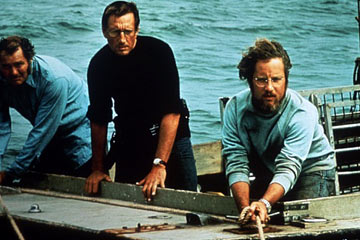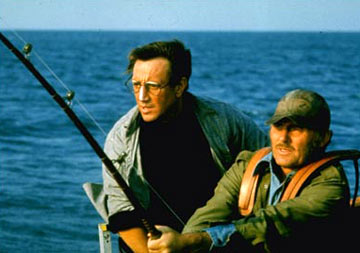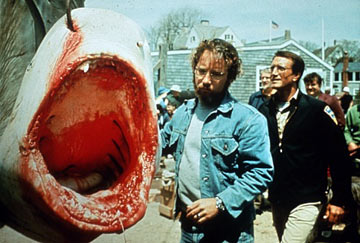
JAWS Screenwriter Discusses how Film Emerged from Chaos to become a Classic
June 21st, 2005

(CP) - Courage and stupidity. Those are the two things Steven Spielberg thinks about when he looks back on his much younger self as he prepared to film Jaws on location on Martha's Vineyard in the spring of 1974.
Of all the Hollywood tales of troubled productions, Jawstook the cake.
And it's all recounted and more in Jaws 30th Anniversary Edition, next Tuesday's two-disc DVD release from Universal Studios.
In a two-hour making-of documentary, Spielberg concedes how naive he was to think he could film Peter Benchley's bestseller in New England and out on the Atlantic Ocean without considerable difficulty.
Carl Gottlieb, who was called in to finish a rough Benchley-Spielberg screenplay and who plays the publisher of the Amity Gazette in the film, concurs that it was a difficult shoot and that it could have ended in disaster.
Instead it has become an acknowledged screen classic as well as the first film to earn $100 million at the box office. It's also credited with starting the summer blockbuster tradition back in 1975.
"I had a couple of advantages," Gottlieb says in a telephone interview from New York. "It was my first produced feature film so I had no fear. More realistically, I came from a five-six-year background of improvisational acting and directing and I knew good work could be created quickly, on the fly."

In his 1975 book Jaws Log, which is enjoying a new hardcover re-issue by Newmarket Press, Gottlieb explains how the film was rushed into production without a finished script.
He found himself acting in scenes by day and dashing off pages of rewrites by night. That only added to the chaos created by a mechanical shark that refused to work properly and island residents who resented the film crew's presence and harassed them at every turn.
"It's like American troops in Sicily in World War Two. You're not quite sure who your pals are, and it's nice country - some people seem happy to see you - and at the same time you've got a job to do and you gotta not get killed."
Filming dragged on for five months and the production soared over budget. Even author Benchley and actor Richard Dreyfuss were bad-mouthing the operation. But the dailies that were sent back to Universal looked good so they slogged on.
Ironically, while the notoriously insular locals made life miserable for cast and crew, last weekend Martha's Vineyard (which played the fictional resort town of Amity) held Jaws Fest, a celebration tied to the anniversary video release and attended by Benchley, Gottlieb and other surviving cast and crew members.

"Yeah, it's the first time in 30 years that they've acknowledged that we made the movie there," Gottlieb says. "Which was actually pretty big of them, I guess."
So what is it about Jaws that is so enduring, apart from it being simply a rousing adventure of the sea and a downright scary monster movie?
Gottlieb sees several factors. It's a classic hero's journey, a quest for the Holy Grail, as well as a rare dramatic form that uses three characters of equal heroism.
There are also echoes of Homer's Odyssey with Penelope (Chief Brodie's wife) waiting onshore for her husband to return. And to top it all off, it has the perfect villain.
"You know, can't be dissuaded, can't be reasoned with, has only one purpose and it's biological determinism, it's not like the shark could change, you know, if he saw the error of his ways."
Indeed Jaws' storyline is exquisitely balanced and with characters that are fleshed out in more detail than one usually expects from a summer thriller. But Gottlieb says the script could have gone in different ways that in hindsight seem totally implausible.
There was the suggestion Mayor Vaughn (Murray Hamilton) had Mafia connections, a finale in which sharkhunter Quint (Robert Shaw) dies Ahab-style by getting entangled with the shark's body and drowning, instead of being eaten by the big predator.
Oh, and oceanographer Matt Hooper was supposed to die, too.
But most unconvincing looking back was the original story's subplot about a sexual affair between Hooper (a young Dreyfuss) and Brody's wife (Lorraine Gary).
"Once you looked at their personas and other scenes that were shot, you go 'Geez, these are nice people, they're not philanderers or sexually repressed. It just doesn't work'.
"It turned out to be just a drag on the narrative that we had."
Source: Canadian Press
Comments
Only logged-in members can comment. You can log in or join today for free!
Advertisement






